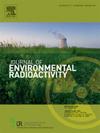Long-term transfer of 137Cs in sensitive agricultural environments after the Chornobyl fallout in Sweden
IF 1.9
3区 环境科学与生态学
Q3 ENVIRONMENTAL SCIENCES
引用次数: 0
Abstract
In this study, the long-term transfer of 137Cs from soil to grass on Swedish farms and fields, heavily contaminated after the 1986 radioactive fallout, was investigated. The study spans over 8–14 years, beginning in June 1986, and covers various soil types and agricultural practices. The transfer of 137Cs from soil to grass was highly variable, with transfer factors ranging from 1.0 × 10−5 to 0.357 m2 kg−1. Higher values were observed on fields with sandy loam, loamy sand, and organic soils, and lower values on fields with a high clay content. The transfer of 137Cs to grass generally exhibited an exponential decline across the majority of fields over the years. The rate of decrease was most pronounced in clay loam and silty loam soils, while it was least evident in sandy loam, sandy soils, and peat soils. The soil properties and farming practices were more important for 137Cs uptake than the initial deposition density. The transfer factor had a negative correlation with soil pH, clay, and fine silt content. No significant relationships were found with other soil variables, such as soil organic matter content and plant available potassium concentration. The median effective half-life of 137Cs in the grass was 4.5 years, with a range of 2–18 years. The uptake of 137Cs by plants did not correlate with the potassium concentration in grass tissues; however, the activity concentration of 137Cs in grass correlated negatively with the potassium content in the plants grown on fields with high deposition levels.
瑞典切尔诺贝利核泄漏后,137Cs在敏感农业环境中的长期转移。
在这项研究中,研究了1986年放射性沉降物严重污染的瑞典农场和田地的137Cs从土壤到草的长期转移。该研究从1986年6月开始,历时8-14年,涵盖了各种土壤类型和农业实践。137Cs从土壤向草地的转移变化较大,转移因子在1.0 × 10-5 ~ 0.357 m2 kg-1之间。含砂壤土、壤土和有机土的土壤土壤磷含量较高,粘土含量高的土壤土壤磷含量较低。137Cs向草地的转移总体上呈指数递减趋势。其中,粘壤土和粉质壤土的下降幅度最大,砂壤土、砂质土和泥炭土的下降幅度最小。土壤性质和耕作方式对137Cs的吸收比初始沉积密度更重要。传递因子与土壤pH、粘土、细粉含量呈负相关。与土壤有机质含量、植物速效钾浓度等其他土壤变量无显著相关。137Cs在草中的中位有效半衰期为4.5年,范围为2 ~ 18年。植物对137Cs的吸收与草组织中钾的浓度不相关;草地137Cs活性浓度与高沉降田中植物钾含量呈负相关。
本文章由计算机程序翻译,如有差异,请以英文原文为准。
求助全文
约1分钟内获得全文
求助全文
来源期刊

Journal of environmental radioactivity
环境科学-环境科学
CiteScore
4.70
自引率
13.00%
发文量
209
审稿时长
73 days
期刊介绍:
The Journal of Environmental Radioactivity provides a coherent international forum for publication of original research or review papers on any aspect of the occurrence of radioactivity in natural systems.
Relevant subject areas range from applications of environmental radionuclides as mechanistic or timescale tracers of natural processes to assessments of the radioecological or radiological effects of ambient radioactivity. Papers deal with naturally occurring nuclides or with those created and released by man through nuclear weapons manufacture and testing, energy production, fuel-cycle technology, etc. Reports on radioactivity in the oceans, sediments, rivers, lakes, groundwaters, soils, atmosphere and all divisions of the biosphere are welcomed, but these should not simply be of a monitoring nature unless the data are particularly innovative.
 求助内容:
求助内容: 应助结果提醒方式:
应助结果提醒方式:


